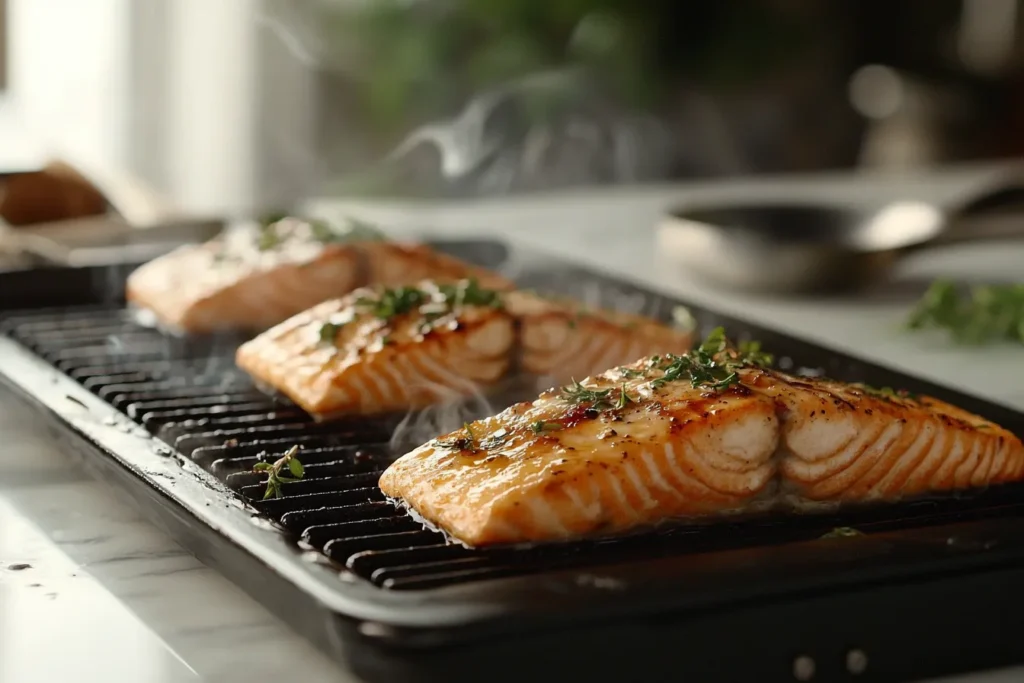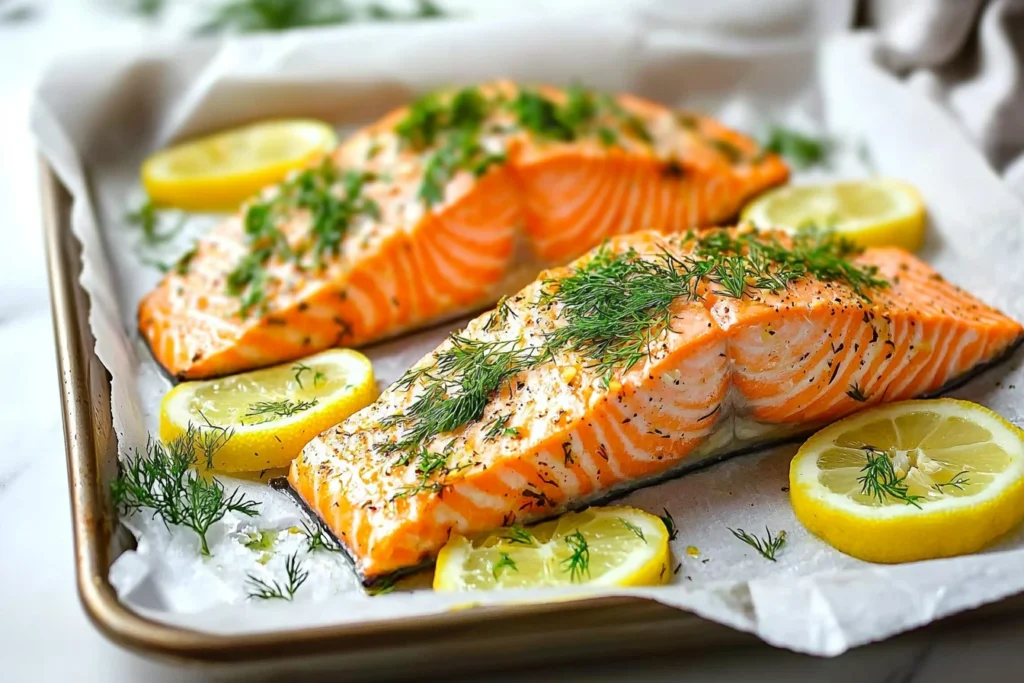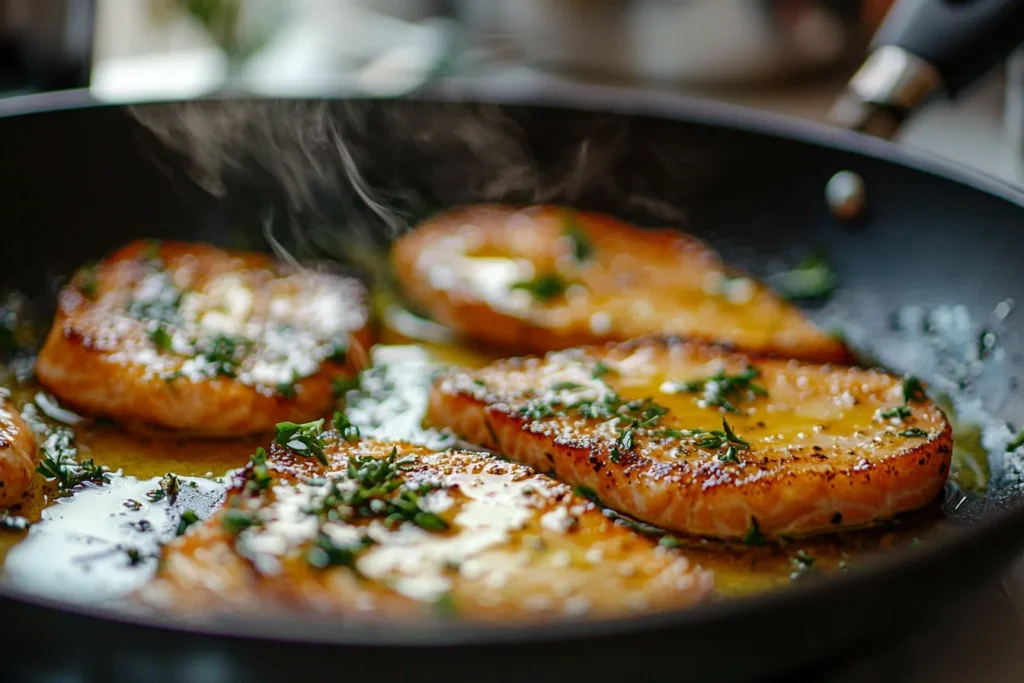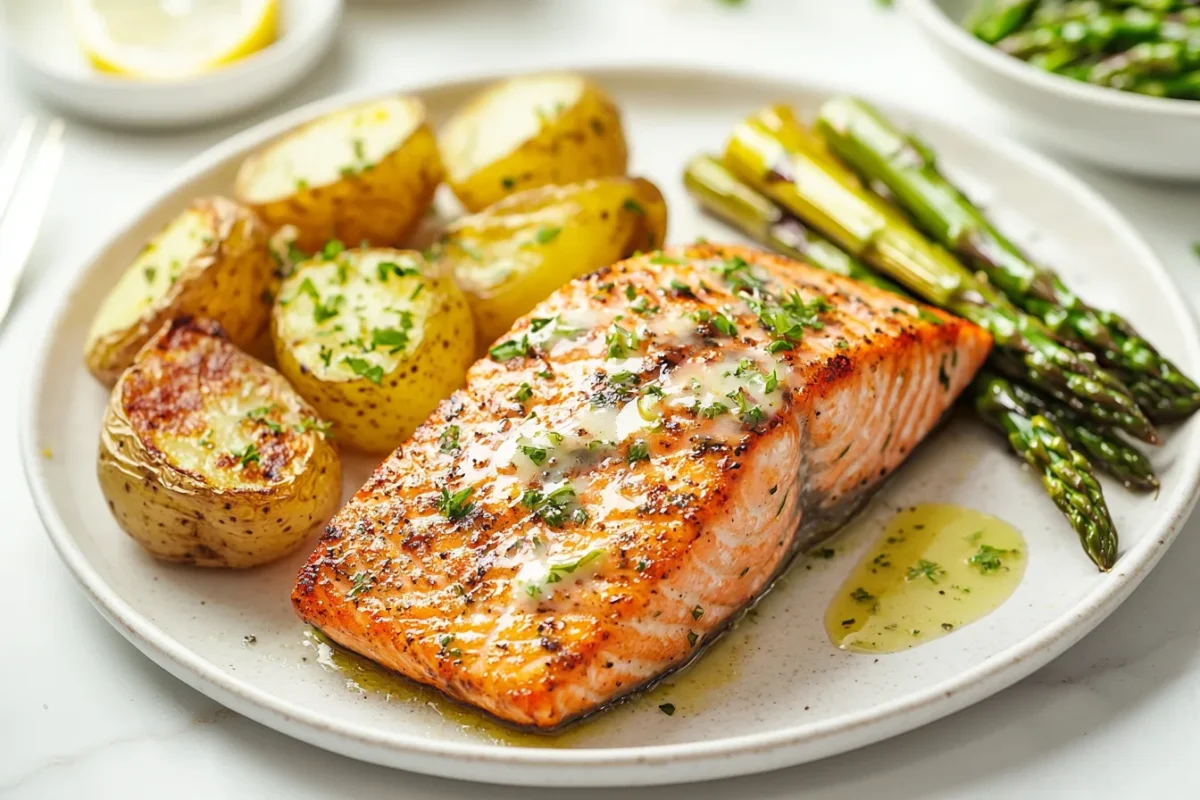What is the tastiest way to cook salmon? It’s a question many of us ask when faced with this versatile and flavorful fish. You want a method that brings out its rich taste and tender texture without too much effort. Sometimes, it feels tricky to pick the best cooking style, but don’t worry—we’ve got you covered.
Salmon is not just delicious; it’s also packed with nutrients. First, it’s rich in omega-3s and protein, making it a healthy choice. Next, it’s easy to cook, whether you bake, grill, or pan-sear it. In addition, salmon’s adaptability makes it perfect for busy weeknights or elegant dinners. Explore the tastiest way to cook salmon and make your next meal unforgettable.
You’re going to love discovering new ways to enjoy this amazing fish. So, keep reading to find tips, tricks, and inspiration to make your salmon dishes unforgettable. Let’s dive into the tastiest ways to cook salmon together!
Table of Contents
The Art of Perfectly Cooking Salmon
Key Tips for Ensuring Flavorful Results
What is the tastiest way to cook salmon? It begins with simple steps that bring out its rich flavors. First, always start with fresh or properly thawed salmon fillets. This ensures a clean, natural taste essential for a delicious dish. Next, pat the fillets dry to remove excess moisture. Dry fillets allow seasonings to stick better and create a beautiful crust when cooked. Also, seasoning generously with salt and pepper enhances salmon’s natural richness. Learn how king salmon should be cooked for the best results for more expert tips.
For cooking, preheating is key. Whether grilling, baking, or pan-searing, make sure your oven, grill, or pan is fully heated. This step locks in moisture and prevents overcooking. Additionally, keeping the fillets skin-side down for most of the cooking time preserves their structure and flavor.
Finally, let the salmon rest for a minute after cooking. This step redistributes juices, making every bite juicy and tender. Try these tips today, and your salmon will be a guaranteed success!
Common Mistakes to Avoid When Cooking Salmon
Avoiding common mistakes can make a huge difference in your salmon dishes. First, don’t cook salmon straight from the fridge. Letting it rest at room temperature for 10 minutes helps it cook evenly. Also, avoid overcrowding your pan or baking dish. Each piece needs space to cook properly and develop a perfect crust.
Next, resist the urge to overcook. Salmon should be removed from the heat once the internal temperature reaches 145°F. It continues cooking slightly even after removal. Additionally, skipping the skin-side cooking step is a missed opportunity. The skin not only protects the fillet but also adds a delightful crunch when cooked properly.
Finally, don’t skimp on flavor. Marinades, glazes, or simple herbs can elevate salmon to a whole new level. By avoiding these mistakes, you’ll turn an average dish into something unforgettable every time!
Exploring Popular Cooking Methods for Salmon
Why Grilling Enhances the Natural Flavors
Grilling salmon answers the question, “What is the tastiest way to cook salmon?” by highlighting its natural richness and smoky undertones.

First, preheating the grill ensures even cooking and perfect sear marks. Using medium heat prevents the salmon from drying out and keeps it moist. Skin-on fillets are perfect for grilling because they hold the fish together and add a delicious crisp texture.
Brush the grill grates with oil to prevent sticking. Next, season the salmon with simple ingredients like olive oil, salt, and pepper to let its natural flavors shine. The high heat of the grill caramelizes the exterior while keeping the inside tender and flaky. Additionally, adding a sprig of fresh herbs or a squeeze of citrus enhances the smoky flavor.
Try grilling salmon for your next outdoor gathering and enjoy a perfectly balanced, flavorful dish! This method transforms salmon into a memorable treat that everyone will love.
The Appeal of Oven-Baking for Consistent Texture
Oven-baking salmon provides a foolproof way to achieve even cooking and a melt-in-your-mouth texture.

Start by preheating the oven to ensure the fish cooks consistently. Line a baking sheet with parchment paper to make cleanup easy and prevent sticking. Baking works well with skinless or skin-on fillets, depending on your preference.
Season the salmon with a combination of fresh herbs, lemon juice, and a drizzle of olive oil. Baking at a moderate temperature, such as 375°F, allows the fish to cook gently and retain its moisture. The result is a soft, flaky texture that pairs beautifully with a variety of sides. Adding a glaze, like honey mustard or garlic butter, can further enhance the flavor. Oven-baking is perfect for busy nights or when you want a dependable, delicious salmon dish!
Unlocking the Secrets of Pan-Searing Salmon
Techniques for Achieving a Crispy, Golden Crust
Pan-searing salmon is an easy way to create a deliciously crispy crust while keeping the inside tender.

Start by patting the salmon dry with a paper towel to remove any moisture. This step is crucial for achieving that irresistible golden-brown finish. Next, heat a non-stick skillet over medium-high heat and add a drizzle of oil until it shimmers.
Place the salmon skin-side down and press gently with a spatula to ensure even contact with the pan. This prevents the edges from curling up while the skin crisps beautifully. Avoid moving the fillets too soon, as this can disrupt the crust. Cook for about four minutes, flip carefully, and cook for another two to three minutes. The result is a flavorful, crispy crust that complements the tender, juicy interior. You’ll love how quick and satisfying this method is!
Timing and Heat Control for Pan-Searing Perfection
Perfecting pan-seared salmon comes down to managing heat and timing. Begin by preheating the pan thoroughly, as this ensures an even cooking surface. Medium-high heat works best to achieve a golden crust without overcooking the fish. Lower the heat slightly after flipping the salmon to avoid burning and to cook the fillets evenly.
For fillets about an inch thick, sear the skin-side down for four to five minutes until it releases easily from the pan. Flip gently using a spatula to maintain the fillet’s shape. Cook the flesh side for two to three minutes until the salmon is just opaque in the center. A quick squeeze of lemon juice over the fillets before serving adds a burst of freshness. Pan-searing delivers a beautiful contrast of textures, making it a top choice for any meal!
Using Marinades and Seasonings to Elevate Salmon Dishes
Best Ingredients to Complement Salmon’s Richness
Marinating salmon enhances its natural flavors while adding exciting new dimensions to the dish. Ingredients like olive oil, soy sauce, and fresh citrus juices work perfectly as a base. These not only add flavor but also tenderize the fish for a more succulent bite every time. Herbs like dill, parsley, and thyme pair beautifully with salmon’s richness, creating a balanced and aromatic profile.
Adding garlic, ginger, or a touch of honey can introduce depth and sweetness to the marinade. Don’t forget spices—smoked paprika or cumin can bring a subtle warmth and earthy undertone. Let the salmon marinate for 20 to 30 minutes for the best results. Over-marinating can overpower the delicate fish, so keep it simple and balanced for optimal flavor. You’ll love how these ingredients elevate your salmon dish into something extraordinary, whether you’re baking, grilling, or pan-searing. Try it soon for an impressive meal!
Tips for Balancing Bold and Subtle Flavors
Striking the perfect balance of flavors is key when seasoning salmon for maximum enjoyment. Start by identifying the star ingredient—whether it’s a tangy lemon marinade or a smoky spice rub. Next, use complementary flavors to enhance the dish without overpowering the fish’s natural taste. For example, pair bold spices like cayenne or chili flakes with mellow elements like olive oil or honey.
Additionally, layering flavors creates depth without making the dish overwhelming or masking its key qualities. Add fresh herbs at the end of cooking to preserve their vibrant aroma. A sprinkle of flaky sea salt or a drizzle of citrus just before serving adds a final burst of brightness. This balance ensures every bite highlights the salmon’s natural richness and freshness. Experimenting with seasonings is fun, rewarding, and allows you to customize dishes easily—you’ll quickly find your favorite combinations that suit any occasion!
How Salmon’s Freshness Impacts the Cooking Experience
Choosing the Best Quality Salmon for Your Recipe
The quality of salmon plays a huge role in its flavor and texture. Fresh salmon should have bright, firm flesh that bounces back when gently pressed. The skin should look shiny, and the smell should be light and ocean-like. Whole salmon should have clear, bright eyes without cloudiness. Wild-caught salmon is often prized for its superior taste and nutritional profile, though farmed options can also deliver good results if sourced from reputable farms.
When selecting fillets, avoid pieces with dull, dry, or curling edges. For a more robust flavor, look for darker cuts from closer to the belly. Frozen salmon is also a fantastic choice when fresh isn’t available, as modern freezing techniques preserve its taste and texture. To learn more about the nutritional benefits of salmon, visit the MyPlate Protein Foods Guide. Opting for high-quality salmon ensures every dish shines, no matter how it’s prepared. Investing in good salmon transforms a simple meal into a truly delicious experience.
Handling and Storing Salmon for Optimal Flavor
Proper handling and storage are crucial to maintaining salmon’s quality and taste. Start by storing fresh salmon in the coldest part of your refrigerator and use it within two days for the best results. Wrap it tightly in parchment paper or plastic wrap to prevent it from drying out. If freezing, use vacuum-sealed packaging or wrap the fillets in plastic wrap, followed by aluminum foil, to avoid freezer burn.
When thawing frozen salmon, always do so in the refrigerator overnight for even defrosting. Avoid thawing at room temperature, as this can compromise its texture and safety. Before cooking, pat the salmon dry with paper towels to remove excess moisture, which helps achieve a crispy exterior. These simple steps not only preserve the salmon’s natural flavors but also make every bite tender and delicious. Handling your fish with care ensures your efforts in the kitchen are well rewarded.
Salmon Dishes That Impress for Any Occasion
Creative Ideas for Everyday Meals and Celebrations
Salmon’s versatility makes it the star of both casual dinners and special celebrations. For an everyday meal, try a quick pan-seared salmon topped with a drizzle of lemon butter. It’s fast, flavorful, and pairs beautifully with simple sides like steamed vegetables or mashed potatoes. For a family-style dinner, bake a whole salmon with a medley of herbs and citrus. The aroma alone will impress everyone at the table.
Celebrations call for elegant dishes like grilled salmon with a honey-glaze or herb-crusted baked salmon.

Add an extra touch by serving it with a creamy dill sauce or zesty mango salsa. Leftovers can transform into mouthwatering salads, salmon cakes, or wraps. Discover perfect sides for your salmon dishes to complete your meal with exciting pairings.
Salmon’s ability to adapt to different occasions ensures it’s always a favorite. It truly answers the question, “What is the tastiest way to cook salmon?” Whether casual or formal, it’s the ideal dish to make a lasting impression.
Why Salmon is a Favorite for Both Chefs and Home Cooks
Salmon is loved by chefs and home cooks alike for its rich flavor and ease of preparation. It’s a forgiving fish, making it perfect for beginners who might worry about overcooking. For professionals, salmon offers endless creativity with marinades, rubs, and cooking techniques. Its buttery texture and ability to absorb flavors make it a versatile canvas for culinary experimentation.
Additionally, salmon’s quick cooking time is a bonus for busy home cooks. A perfectly pan-seared fillet can be ready in minutes, while baked or grilled salmon requires little hands-on time. Chefs love using salmon to showcase their skills, from sushi to gourmet entrées. This adaptability and universal appeal make salmon the go-to choice for meals that are both simple and sophisticated. Whether you’re a beginner or a seasoned pro, salmon never disappoints.
Frequently Asked Questions (FAQs)
What is the best cooking method for salmon?
The best cooking method for salmon depends on your taste preferences and desired texture. Grilling gives it a smoky flavor and crispy skin, perfect for a barbecue vibe.
Baking is another great choice, as it ensures even cooking and keeps the salmon moist. For a quick option, pan-searing creates a golden crust while locking in the juices.
Each method brings out unique flavors, so try a few and see which one you like most. With simple seasoning and a little care, salmon is delicious no matter how you cook it. What’s your favorite method? Let us know!
Is it better to cook salmon in the oven or on the stove?
Both the oven and the stove offer great results, but each method has unique advantages. The oven is ideal for even cooking and maintaining moisture. It’s also perfect if you’re cooking multiple fillets at once.
On the stove, you can achieve a beautiful golden crust with pan-searing. This method works best when you want crispy skin or a quick meal.
For the tastiest way to cook salmon, try combining both methods. Start with a sear on the stove and finish in the oven for perfect texture. Which do you prefer?
What is the secret to the best salmon?
The secret to the best salmon lies in choosing fresh, high-quality fillets and simple preparation. Fresh salmon has vibrant color and a clean smell.
Seasoning also plays a key role. A mix of salt, pepper, and a drizzle of olive oil enhances the fish’s natural flavors. Cooking it to the right temperature is crucial. Overcooking dries it out, so aim for an internal temperature of 145°F.
Finally, use fresh herbs, citrus, or a flavorful glaze to add a special touch. What’s your favorite secret for perfect salmon?
What helps salmon taste better?
Adding the right seasonings and ingredients can make salmon taste even better. Start with a sprinkle of sea salt and freshly ground black pepper. These enhance its natural flavor.
Next, try adding citrus like lemon or orange slices. The acidity brightens the dish and balances its richness. Fresh herbs like dill, parsley, or thyme bring an earthy depth.
Finally, marinating the salmon with a mix of olive oil, garlic, and soy sauce adds a savory kick. What do you love adding to your salmon for that extra flavor boost?
Bring Out the Best in Your Salmon Cooking Adventures
Cooking salmon offers endless possibilities for creating delicious and memorable meals. Whether you grill it, bake it, or pan-sear it, each method brings out unique flavors and textures. The key is finding the tastiest way to cook salmon that matches your preferences and complements your favorite sides. First, consider what appeals most to your taste buds—crispy skin, tender flakes, or a hint of smoky char.
Next, explore how marinades and seasonings can transform this versatile fish into a culinary masterpiece. Experimenting with citrus, herbs, and bold spices adds depth and excitement to every bite. Also, don’t forget the joy of pairing your salmon with vibrant vegetables or hearty grains for a complete meal.
Now it’s your turn to try these ideas and discover your favorite method. Share your experience or tips in the comments below! Let’s celebrate the endless ways to enjoy perfectly cooked salmon together. You’ve got this!

